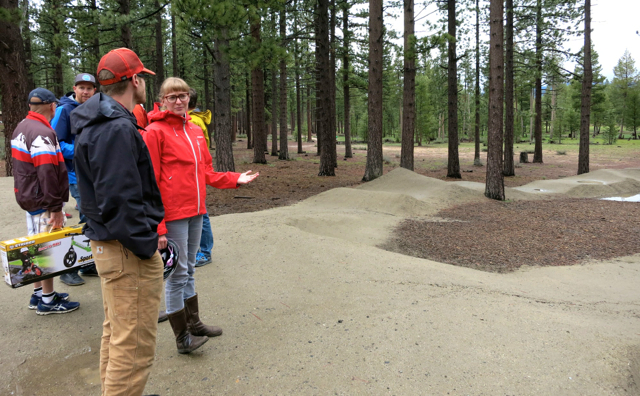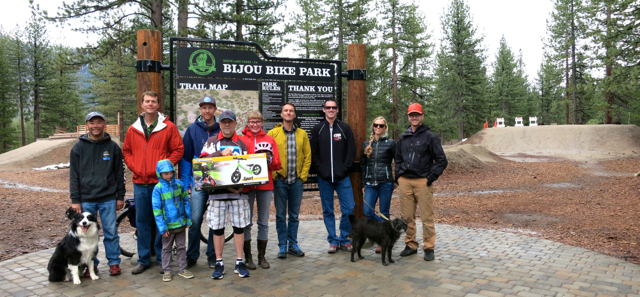Cycling summit highlights South Shore’s growing prominence in world of mountain biking

Amy Fish talks about the features of the bike park at Bijou that opened last year. Photo/Jessie Marchesseau
By Jessie Marchesseau
It takes more than a little rain to keep mountain bikers indoors. Riding enthusiasts donned rain jackets and jumped over puddles as they toured the Bijou Bike Park on Saturday afternoon as part of the 2016 Tahoe Trails Summit.
The Tahoe Area Mountain Biking Association in partnership with the U.S. Forest Service Lake Tahoe Basin Management Unit and the Beach Retreat & Lodge at Tahoe hosted the May 6-8 event.
Consisting of trail tech talks, presentations, panel discussions, Q&A sessions, social events and, of course, riding, the summit was designed to bring together a variety of trail users and experts to celebrate the progress made on Tahoe trails in recent years, introduce what’s happening now and open a dialogue about where to go from here.
The weekend’s speaker list was diverse, including South Lake Tahoe’s mayor pro tem Austin Sass; founder of Ibis Bicycles, Scot Nicol; Mammoth Lakes Council member John Wentworth; athlete and adventurer Chris McNamara; Sierra Buttes Trail Stewardship Executive Director Greg Williams; Tahoe Rim Trail Executive Director Morgan Fessler; and representatives from TAMBA, Heavenly and the USFS.
Gary Sjoquist, advocacy director for Quality Bicycle Products, the largest distributor of bike parts in the world, was also one of Saturday’s presenters. He spoke about the potential of Lake Tahoe becoming a true mountain biking destination.
Sjoquist has traveled to biking destinations all over the country. He said he sees a few things in Tahoe that make it truly unique, one being the amazing scenery the location offers pretty much everywhere you look. He said we also have a rare combination of officials who realize the importance of recreation to our local economy, forward-thinking individuals with the USFS and motivated community members who are all willing to work together to make a great trail system happen.
Ben Fish, president of TAMBA, is one of those people. Fish played a major role in organizing the summit, acted as a panelist, a presenter and host of Saturday’s bike park tour.

Cycling advocates are ensuring the South Shore is a destination for mountain bikers. Photo/Jessie Marchessea
As the group walked the track, rain wetting the already muddy ground, Fish showed how the park has multiple lines to accommodate riders with a variety of skill levels and riding styles. The slopestyle track, he explained, the one with the bigger jumps, is by far the most popular. Riders have been known to perform a variety of flips and tricks over the jumps that were intentionally built in full view of Al Tahoe Boulevard.
The smaller pump track appeals more to BMX riders and the younger crowd. Fish’s wife, Amy, said the medium track is her favorite. And there is also talk of building an additional smaller track to accommodate still younger riders on strider bikes, two-wheel bikes kids push with their feet rather than using pedals.
Amy Fish said the bike park has also become a place for riders who were once out building illegal trails and jumps on USFS land to come and play. She is now seeing some of these riders help with maintenance in the bike park as well as TAMBA’s organized trail building events. Keeping these riders interested is one reason they intend to periodically alter and upgrade the bike park tracks.
“If they don’t feel like they can change things and have fun with it, they’ll go back to the woods,” she said.
When it comes to building bike tracks, they have learned some lessons, such as how adding a layer of glue on top of the track actually makes maintenance harder and putting a teeter-totter feature in the middle of a track isn’t such a good idea. These lessons will make the park better in the long run.
More than one attendee pointed out the current lack of connectivity to other bike trails, making it difficult for people to actually ride their bikes to and from the park. Current projects such as the Greenway bike trail should resolve that issue in the near future.
“That’s the dream,” Ben Fish said, “that everyone will be able to ride right from their hotel room or their house, and they can get to the bike park or go on an epic 35-mile ride.”
This summit was part of making that dream a reality.
Jacob Quinn, USFS trails engineer, pointed out the dramatic trail improvements the community has seen since the first trail summit in 2010. He said we are fortunate to have such active groups and productive partnerships when it comes to improving our trails system.
“As a trail community, we’re in a really good place right now,” he said.
Even so, Fish said he sees a new energy and more dynamic partnerships resulting from the weekend’s discourse. This energy could fuel area trail improvements and collaborations for the next five years, and possibly beyond.


